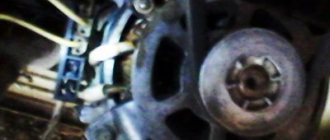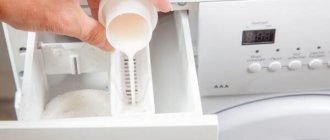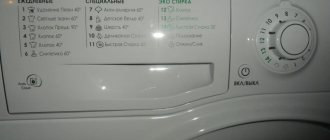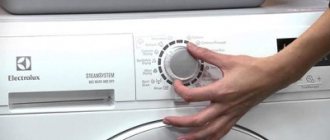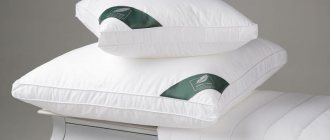Device design
Any washing machine consists of the following components:
- Frame. Protects internal equipment elements from damage.
- Drum. A moving part that allows the laundry to rotate during washing.
- Engine. The main force that rotates the drum.
- Tank. A container into which laundry is loaded.
- Pumps. Devices for filling the tank with water and removing excess moisture at the end of washing.
- Power block. Provides energy to the engine and electronic components of the system.
- Electronics. This includes the main control unit, sensors and switches for setting the operating mode of the machine.
How to prepare clothes for washing?
Clothes must have a label with instructions for washing. Always look at this information so as not to spoil things because something cannot be washed in hot water, or cannot be washed with bleach, or in general can only be washed by hand. Do not put items labeled with labels such as dry cleaning in the washing machine.
Organize items by color. Because one color can stain all your clothes. Sort into dark and light colors and denim items. Sort clothes into heavy and light ones. This will help the fabric look new for a long time. Heavy fabric includes jackets, fur coats, various bath accessories, sweaters, and cotton products.
To protect delicate clothing, it can be placed in the washing tray. But choose everything strictly according to color, maybe with a light fabric.
Separate clothes according to their stains; some heavy stains require separate preparation, such as greasy stains. Please note that at high temperatures, some stains are very difficult to remove, so it is highly undesirable to use it.
Water supply
Water is supplied to the washing machine through special hoses connected to the water supply in the apartment. How long it takes to fill the tank depends on the equipment parameters. The system can be set to a certain level for washing.
The design also includes pressure monitors, which are small sealed containers with membranes at the inlet. As soon as the desired water level is reached, the pressure inside the container increases. The contact system allows you to close the valve, thereby stopping the flow.
Some machines use pressure sensors in the form of special electronic controllers created using semiconductor technology. In this case, increasing water level with increasing pressure changes the electrical conductive characteristics of the device. The received signal is sent to the control board.
The regulators protect the system from flooding, prevent the heating element from running dry, and also act as foam detectors.
Preparing laundry
To ensure maximum washing efficiency, follow these rules:
- Sort laundry by color and fabric type.
- Check all pockets - often important things remain forgotten in them, which will be irrevocably damaged after washing. In addition, they can stain clothes and damage the washing machine (passport, coins, paper clips, etc.).
- To ensure that your laundry is washed and rinsed properly, do not pack the machine drum too tightly.
- It is not recommended to wash items one at a time or to place very large and very small items together.
- For delicate laundry, it is recommended to use special laundry bags.
- Wash items with small decorations with caution: you can not only damage the decoration, but also damage the machine. If some parts do not stick well to the clothes, they should be torn off or sewn on more firmly before washing.
- If there are an abundance of decorative elements on clothes, choose manual or delicate washing mode.
- If things only need to be slightly refreshed, use an economical or fast wash cycle (to reduce the consumption of water and household chemicals).
Water heating
As soon as the tank of the machine is filled, a special control board activates the heating element, represented by a traditional tubular heating element system. The element increases the temperature of the water until the thermistor signals that heating has stopped.
Thus, three devices are involved in the process of heating water: a control board, a thermistor and a heating element. If at least one of the elements stops working correctly, errors will occur. The water may remain cold for the entire wash cycle or, on the contrary, heat up to very high temperatures or even boil.
Washing modes in an automatic machine
The number of modes depends on the manufacturer and its configuration, but in general, the modes of models from the manufacturing company LG and others are similar:
Every washing machine has a cotton mode. It is designed for washing cotton products and bedding. Washing temperature 95 oC. The operating time is about two hours, the laundry is spun at maximum speed.- Items made from synthetic fabrics must be washed in the “synthetic” mode, and the water temperature should not exceed 60 °C, and the washing and spinning times are exactly the same as option number 1.
- For delicate and woolen fabrics, use the “hand wash” mode. In this mode, the water temperature does not exceed 40 °C. Spinning is not provided.
- Many LG washing machine models have a “delicate” function. In terms of its parameters, it is similar to the previous one, but still has a spin.
- The easiest way to freshen things up is to put your car in Express mode. Its operating time will not exceed 30 minutes, and the laundry will become fresh and clean again. It should be noted that the water does not heat up more than 30 ° C during washing.
- For laundry that is too dirty, you can use the “intensive” mode. But you should remember that the water temperature will reach 90 °C.
- How to wash correctly using the “pre-wash” function? To do this, you need to pour washing liquid or pour powder into both containers. Then you need to turn on the machine. For the first wash, powder from the first container is used, and for the second, from the second.
- Some models are equipped with an economy function. Operating the washing machine in this mode saves water and electricity due to the small amount of water used for heating.
Washing process
After loading the laundry into the inside of the washing machine, you need to close the hatch, and then select the desired washing program using the buttons and controls. As soon as the user starts the machine, the machine will lock the hatch and start washing.
Washing steps briefly:
- Engine starting. The motor speed is adjusted using a built-in tachometer. Detergent is placed from the powder container into the main chamber of the machine. At the same moment, the tank is filled with cold water, the volume of which is determined by the selected washing program. This stage involves soaking the laundry.
- Turning on the heating element. The heating of this element is also adjusted using a special sensor. The washing parameters are selected automatically after the user has selected the desired mode using the controls.
- Draining. The machine automatically signals the pump, which turns on the spin function. The pressure switch signals the absence of water in the tank, thereby activating the dial system and starting the rinsing procedure.
- Removing water after rinsing. A spinning procedure is immediately carried out, which is repeated several times.
- Final spin of laundry while rotating at high speeds. Simultaneously with the spin cycle, water is completely pumped out of the tank. Then a signal indicating the completion of the wash is sent to the control board. The hatch will unlock.
The presented algorithm helps to understand how any washing machine works. Almost all modern models operate on the same principle with minor differences.
Subscribe to TechnoCouncil on social networks so you don’t miss anything:
Operating principle of the washing machine
There are two types of washing machines on the household appliances market: front-facing and vertical. Let's look at how parts function in each type of machine.
Why is there a drum in the washing machine?
In a washing machine, an important part, and indeed the very center of the equipment, is the drum, designed for loading dirty laundry. When the program is set and the user starts the machine, the drum begins to move in a circular motion, the laundry falls into the water, which penetrates through many small holes. Once in the powder receptacle, the detergent is mixed with water, forming a soap solution. The items in it are washed mechanically. The process is similar to hand washing, only the machine method does not require any action on your part.
Important! There should be no foreign metal parts or other things in the drum. If a foreign object gets into the machine, it can damage the drum. Repairs will cost you a considerable amount.
How does the tank affect the operation of the machine?
The tank is an important part in the washing machine, which is located around the drum. Different models of machines have tanks made of enameled or stainless steel, as well as plastic. The tank is designed to collect water, while the drum is the actively rotating part necessary to move the laundry. This is the operating principle of an automatic washing machine when doing laundry.
Front-type SMAs are designed for loading laundry through the side hatch. In vertical machines, things are placed through the top lid.
Interesting! According to statistics, tanks made of stainless steel are considered the most durable. With careful use, compliance with all rules and regular maintenance, a machine with a stainless steel tank will last for many years.
Rinsing and draining system
The essence of rinsing is to wash away detergents.
If you are sensitive to chemicals, choose the extra rinse function.
What is the principle of operation of the machine when rinsing clothes?
- The programmer sends a signal to the drain pump to pump out dirty, soapy waste water.
- The waste water leaves the tank completely.
- Rinse begins with clean water, but no powder is added.
- Water begins to flow into the tank, and the drum rotates.
- When the rinse finishes, the water leaves the tank through the drain system.
Spin
The operating diagram of an automatic washing machine during the spin process is extremely simple:
- The drum begins to perform rotational actions at extremely high speed.
- The laundry adheres to the walls of the drum due to centrifugal force.
- The water coming out of the laundry flows into the tank through the holes in the drum.
- The pump pumps water into the sewer.
Important! The spin speed is controlled by the number of drum revolutions. Do you want to get your laundry dry? Set the maximum level.
Spinning is a noisy and active process. Large stones in the SMA body (counterweights) dampen vibrations during spinning. Depending on the choice of program, the spin speed may also vary: usually from 200 to 1200 revolutions. For example, when you choose to wash delicate items, you will see that the spin cycle is set to low speed or turned off. Items made from denser materials that do not require special care can be spun at maximum speed. Please note that you need to select the spin speed before you start washing.
The wash is finished
When all the washing steps described above have been completed and the spin function has worked, the washing process can be considered complete. Before this, the drum rotates several times to evenly distribute the laundry. Stopping the machine notifies the user that the wash is finished. Open the hatch only after pressing the “OFF” key.
Important! If you are unable to open the door, wait a few minutes for the hatch lock to unlock.
We invite you to watch an interesting video:
Approximate prices for repairs
It should be noted here that the specific price may vary in specific cases. In addition, discounts are often provided. Therefore, the final price is determined during negotiations with the technician who must repair the car.
Approximate prices are as follows.
- Emergency diagnostics are free.
- An urgent call costs from 500 rubles.
- Installation of the filter, legs and control knobs (without complex dismantling of the housing) costs from 500 rubles.
- Installation of an element heater (or drain pump, motor), including partial disassembly of the housing from 1000 rubles.
- Replacing the bearings of the drum (the housing is completely dismantled), replacing the entire drum or tank will cost from 2000 rubles.
- Installation and connection after completion of the repair - it will cost from 1200 rubles.
Troubleshooting yourself
To eliminate some malfunctions, it is not necessary to take the device to a service center; you can do everything yourself. To do this, you need to do the following:
- If foreign objects get behind the drum, you need to bend the rubber seal of the hatch on the front panel, fixing the drum. After this, you should hook the item and pull it out. If you can’t do this, the only thing that will help is removing the heating element and disassembling the automatic machine, which is best left to a professional.
- If the laundry is unevenly distributed, you need to perform an emergency drain of water and unlock the hatch. Next, you should take out the laundry, separate them from each other and carefully place them in the drum. If overload is observed, then remove some of the things from the machine.
- If there is a problem with installation, you need to determine the correct height using a level and adjust the legs of the washer. You can also level the floor or lay down a sheet of chipboard, fiberboard, or anti-vibration pads. Using a rubberized mat will also help if the device slides on the surface.
- If there are transport bolts, you need to turn the machine with the back wall towards you and unscrew 3 or 4 fasteners with a wrench or pliers. In some cases, there are more fasteners, and they are located under the top cover, so it is better to check the instructions first. In their place are installed the plastic plugs supplied. The removed bolts should not be thrown away; they will be useful when moving or rearranging during repairs.
- If you have problems with the shock absorbers, you need to unscrew them and try to compress them. Since their task is to dampen vibrations, movement should be difficult. If this is easy to do, it means that both structures need to be replaced. If only one is corrected, the stiffness will be different and the load will be distributed unevenly.
- If there are difficulties with the counterweights, you need to remove the machine panel (using pliers, a screwdriver, a wrench) and inspect the counterweights. If they crumble, then buy and install new ones. If it is not available for sale, you can tighten the parts with metal plates or glue them together, although this is a rather complicated option. When the counterweights look intact, it is worth examining their mountings, as well as the springs. If they break, they are replaced, but if they are intact, the bolts are tightened.
- To resolve the issue with the electric motor, you need to remove the back panel and try to tighten the fasteners. Also, removing the far cover will allow you to determine the condition of the belt leading from the engine to the drum. Other actions with the motor and the programmable part of the device cannot be carried out independently.
- Bearing failure can only be repaired by a service center.
How to reset a program when frozen?
When freezing, resetting the program can sometimes help. Washing machines of different brands do this differently. Let's look at the most popular:
- Indesit, Ariston . If the error code is not displayed, you need to press and hold the “Start” button and wait for the LEDs on the panel to light up and go out. If the machine generates an error, only unplugging it from the outlet for a while will help.
- LG . Press and hold the power button or unplug it from the outlet.
- Samsung . There is no error reset, you need to turn it off and eliminate the cause of the failure.
- Zanussi, Electrolux . The program is reset by turning on pause or disconnecting from the network.

